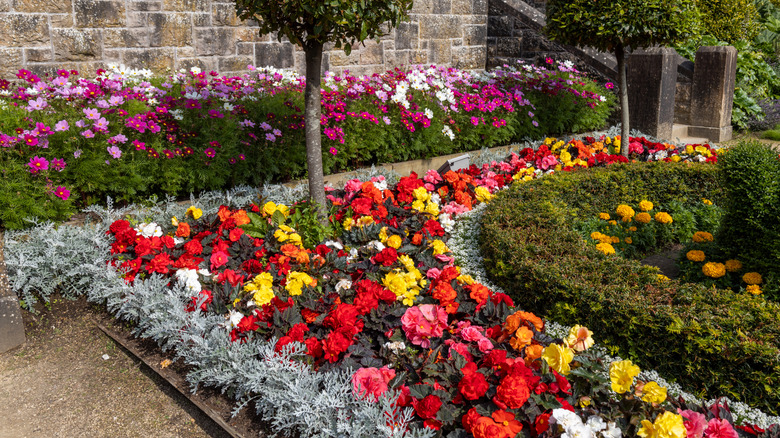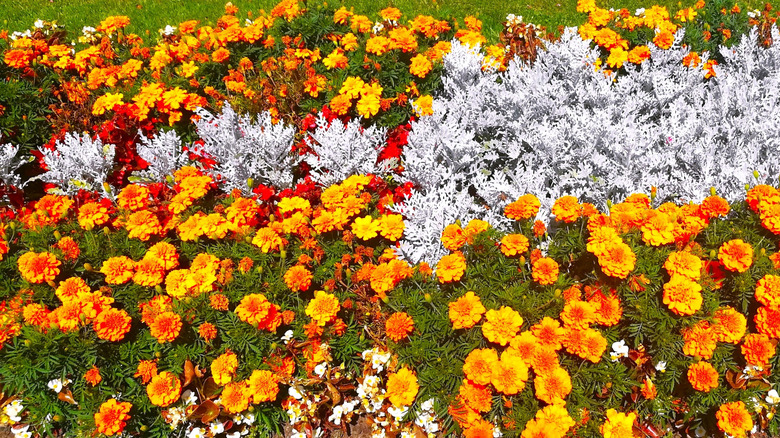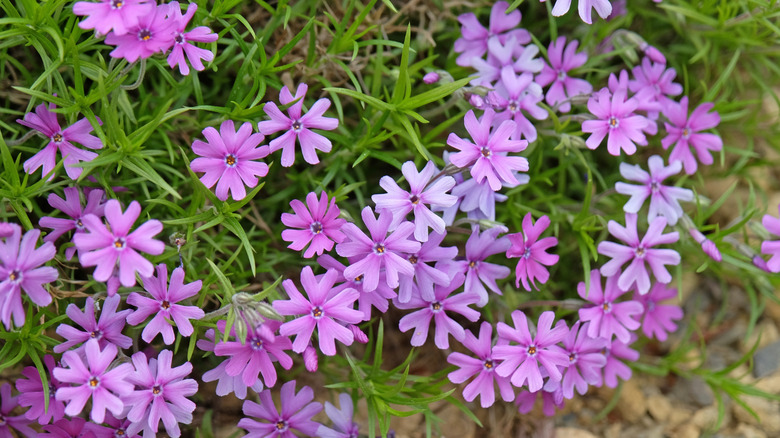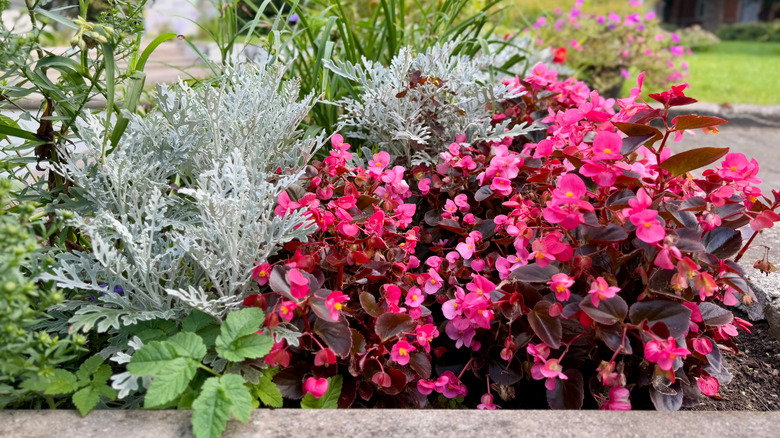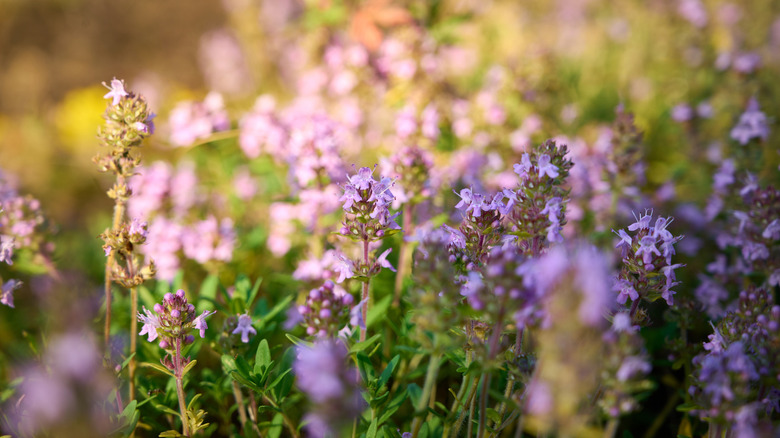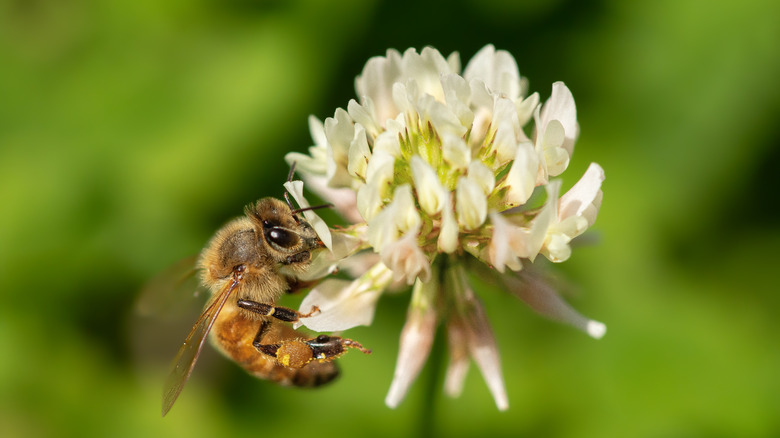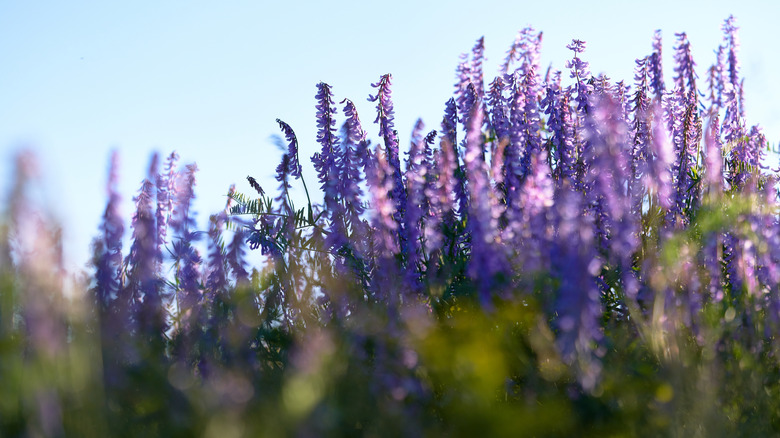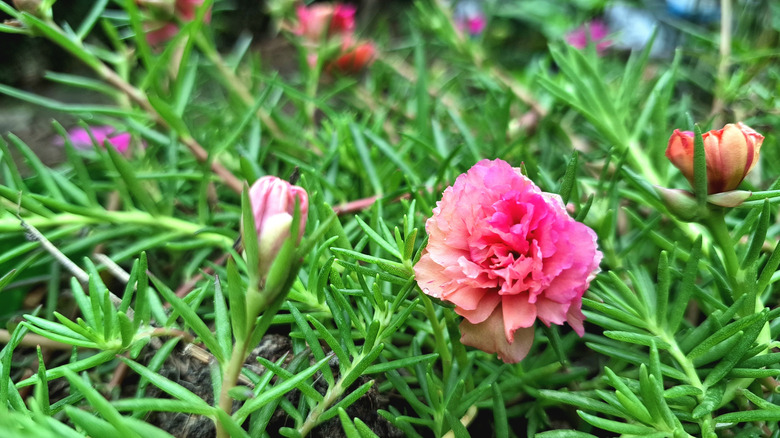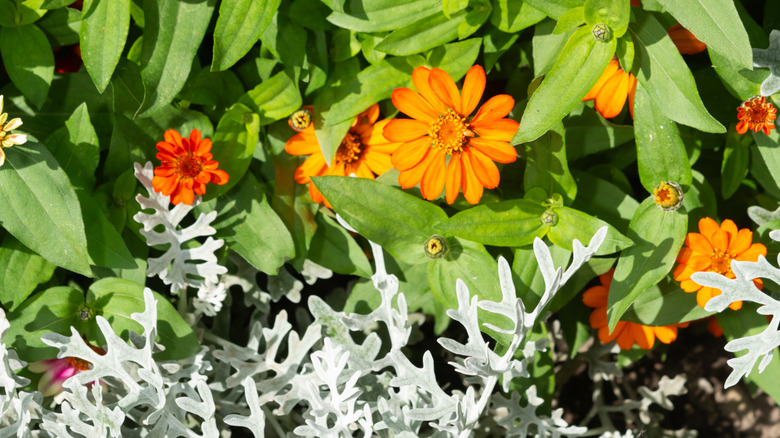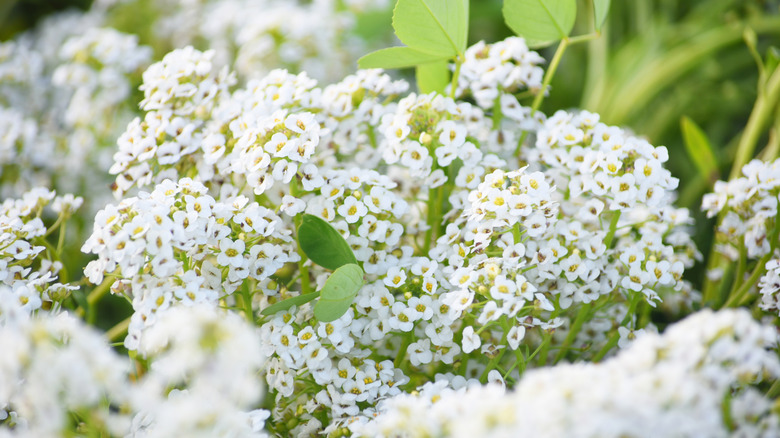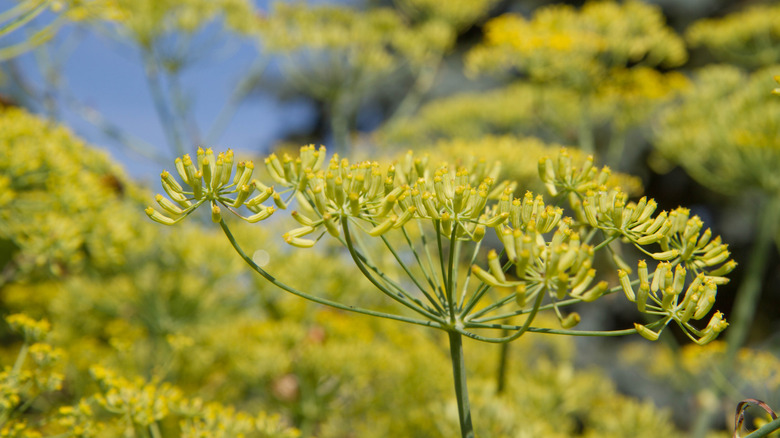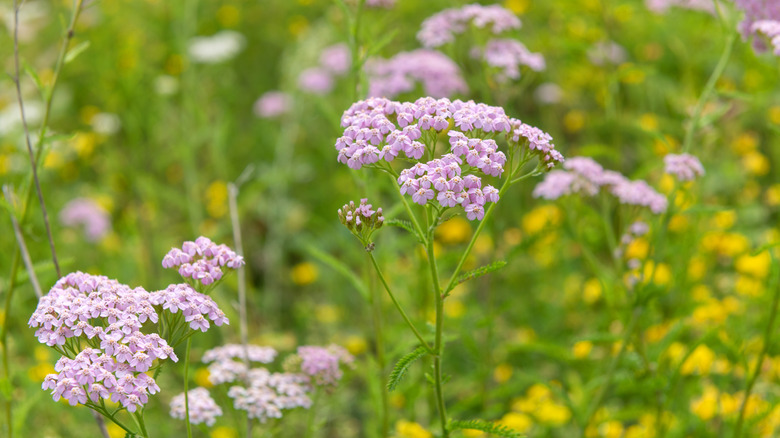16 Companions To Plant And Grow With Dusty Miller
Gardeners love dusty miller (Senecio cineraria), and it's not hard to see why. This striking plant is a perennial in USDA Hardiness Zones 8 through 10, but you can also grow it as an annual outside of these zones. It thrives in full sun but will also tolerate partial shade and prefers moist, well-draining soils. It grows seemingly effortlessly and complements other plants. The silvery leaves on it blend beautifully with colorful annuals and mixed plantings. Furthermore, it is one of those flowering shrubs that will bring a ton of drama to your yard. When you add some companions to your dusty millers, the benefits can go beyond looks. Companion plants can help deter pests, boost soil health, and attract beneficial insects to your garden. Some good companion plants for dusty miller include petunias, begonias, hostas, marigolds, salvias, portulacas, and zinnias.
Do you really need to add companion plants? After all, it is already a pretty hardy plant on its own. It is heat and drought-tolerant, has few pests, and the best part is that deer don't like it very much, so you won't have to spend time learning tips and tricks to prevent deer from eating your flowers. However, when you pair it with the right companion plants, the results become even more magical. They can help keep your dusty millers healthy while also providing many other benefits. And don't we all want a garden that is both beautiful and as healthy as it can be?
Basil
Basil (Ocimum basilicum) belongs to the mint family, and if you are looking for an herb that is easy to grow and keeps pests away from your dusty millers, basil is a top choice. The best part? Basil does it all while also attracting pollinators to the garden. All you have to do is plant it in a warm, sunny, sheltered location, preferably in containers, as that is where it thrives best. But if the soil is well-drained, you can plant it in the ground, too.
Marigold
If you want to pair a burst of yellow color with your dusty millers, try adding marigolds (Tagetes spp.) to your flower beds. This combo not only looks stunning but also provides real benefits to the dusty miller plants. Take, for example, nematodes. They can affect the quantity and quality of flowers on many ornamentals, including dusty miller. But if you pair them with marigolds in your garden, nematodes will be all but gone due to marigolds' allelopathic properties.
Ajuga
Ajuga (Ajuga reptans) is also sometimes referred to as bugleweed, but don't be scared of its name; it is no weed but rather an excellent companion for dusty millers. It is often used as a ground cover, acting as a living mulch where it can help the soil around your flowers retain moisture, and being a perennial plant, you won't have to replace it. Also, it comes in many cultivars of different colors, so you can mix and match with your dusty millers based on what hues you like.
Creeping Phlox
A spring-blooming herbaceous perennial with a dense, mat-forming habit, creeping phlox (Phlox stolonifera) is well known for its ability to control soil erosion. It can be a great companion plant for dusty millers, especially if you're planting on a slope. It can help suppress weeds when planted on exposed ground around your flowers. It is best planted alongside dusty millers growing in partial shade, since full sun can make it perform poorly. Also, be on the lookout for slugs if the soil is moist.
Petunia
Petunias (Petunia x hybrida) are one of those flowers that people just can't seem to get enough of, but they sure don't look attractive to common garden pests. Petunias deter aphids, which, like many other ornamentals, also attack dusty millers. For best results, plant them both in well-drained soil, and especially keep petunias out of heavy soil, as they do not bloom well there. Also, wait till the danger of frost has passed before planting petunias in your flower beds.
Begonia
If you are looking for a companion plant for your dusty millers that performs well in shade, go with begonias (Begonia spp.), as they need less than two hours of sunlight or can even survive without direct sun. In terms of companion plant benefits, they draw in pollinators with their soft, fragrant clusters of pink blooms. If, however, you want to plant them with your dusty millers in a sunny pot, give them some extra water, but make sure not to keep them too wet.
Hosta
Hosta (Hosta spp.) is another excellent option for shade-tolerant companion plants to go with dusty millers. Not only does their dense foliage help crowd out weeds, but their elegant, often fragrant blooms also attract pollinators, such as hummingbirds and bees, to the garden. However, if slugs are a common issue in your area, then don't go with hostas. Slugs are among the most common problems when growing hostas, but other than that, they are pretty easy to care for and last for many years.
Lupine
While dusty miller is tolerant of poor soils, it will grow much better in rich soils, and lupine (Lupine spp.) is just one of the plants you should have in your garden to naturally enrich the soil. It is a legume, so it fixes nitrogen in the soil, but its benefits don't stop here. It also improves water infiltration into the soil, and its roots can help break up compacted soils. All these things can really help your dusty millers grow better without you breaking a sweat.
Creeping Thyme
Creeping thyme (Thymus serpyllum) is a woody evergreen that forms a dense groundcover with aromatic foliage, and with its beautiful pink flowers, it can add a fantastic look to gardens when planted with dusty millers. Its companion benefits come from its ability to act as a living mulch. It is another excellent option to grow on slopes with dusty millers if soil erosion is an issue. And with its fragrant flowers, you also get the added benefit of pollinators visiting your flower beds.
White Clover
White clover (Trifolium repens) is no ordinary companion plant. It is often also used as a cover crop, and some people even build whole lawns out of it. Nevertheless, when planted with dusty millers, it offers benefits such as enriching the soil by adding nitrogen and helping break up compacted soils with its thick, interconnected root system. Other than that, it can also help retain nutrients in the soil and keep weeds from taking over your dusty miller beds.
Common Sage
Also known as salvia, common sage (Salvia officinalis) is a semi-shrubby, woody-stemmed perennial with excellent ornamental value. Planted alongside dusty millers, it can help deter pests, including fleas and beetles, but when it flowers in summer, it can also draw in pollinators like bees, butterflies, and hummingbirds to your garden. Salvia is tolerant of poor soil and has good drought tolerance. Just make sure to choose a location that has well-drained soil and gets plenty of sun.
Moss Rose
Moss rose (Portulaca grandiflora) is another good companion plant choice for dusty millers, as it also enjoys full sun and is drought-tolerant. You can plant it in pots, hanging baskets, borders, or even tucked into rock and crevice gardens. It provides summer-long nectar and pollen for pollinators, attracting bees and butterflies, which can help pollinate your dusty millers, but be careful when transplanting moss rose plants into your flower beds, as they do not handle the process very well.
Zinnia
Zinnias (Zinnia spp.) make great companions for dusty miller, with varieties ranging from six inches to three feet tall to suit any garden style. It is best to plant them in guard rows around your dusty millers, as they will help send pests away while also attracting pollinators and nature's tiny warriors, like lady beetles and wasps that help keep many garden pests at bay. For best results, plant them in a spot that gets more than eight hours of sunlight every day.
Sweet Alyssum
There are many reasons to like sweet alyssum (Lobularia maritima). It looks pretty, it is easy to grow, and it makes an excellent companion plant. For instance, this plant is known to attract beneficial insects such as hoverflies and predatory wasps. Both of these can play an important role in keeping pest populations in your flower beds under control. You can plant it anytime from October through late spring, as long as the spot gets plenty of sunshine and the soil drains well. A little shade won't hurt either.
Fennel
Few plants are as graceful and functional as fennel (Foeniculum vulgare). It is easy to grow and visually striking. Also, when planted alongside dusty miller, its flowers can attract pollinators and other beneficial insects, such as bees, lacewings, tiny wasps, and butterflies, to the garden. To see fennel at its best, plant it in full sun and loamy, well-drained soil that's rich in organic matter. However, don't put it too close to your other plants because of its allelopathic properties.
Yarrow
Belonging to the daisy family, yarrow (Achillea millefolium) attracts quite a few pollinators and beneficial insects that can be helpful for your dusty millers. It can thrive in most average garden soils and even tolerates poor ones, as long as there is good drainage, but for the best growth, place it in a spot that has acidic soil with a pH of about 4.5 to 7.0 and is moderately rich. Like dusty miller plants, yarrow needs well-drained soils to thrive and does not need much water once established.
